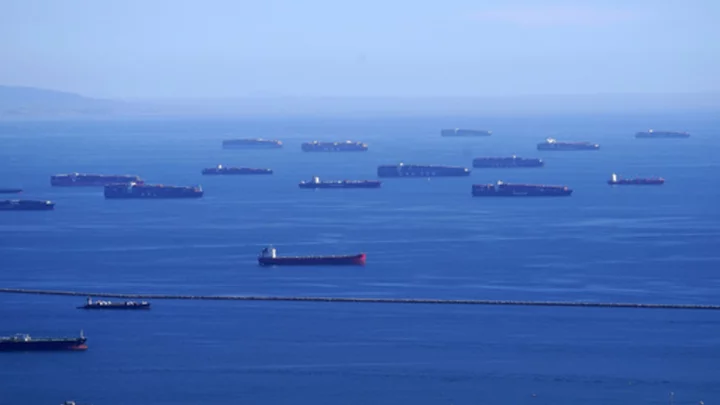Maritime nations have been finalizing a plan Thursday to slash emissions from the shipping industry to net zero by about 2050 but experts warn the deal falls well short of what's needed to prevent climate catastrophe.
Negotiators at the meeting of the United Nations' International Maritime Organization in London, seen as key to limit global warming to 1.5 degrees Celsius (2.7 degrees Fahrenheit) since pre-industrial times, are set to officially agree Friday for shipping emissions to reach net zero “by or around” 2050, rather than setting the date as a hard deadline.
The draft plan also calls for shipping emissions to be slashed by at least 20% but aiming for 30% by 2030 and at least 70% but working toward 80% by 2040 despite a push from Pacific nations for more ambitious targets. Experts calculate the industry must cut its emissions by 45% by 2030 and reach net zero by 2050 to keep on track with 1.5 C temperature goal.
Environmentalists say the draft plan would see the shipping industry use up its carbon budget — a calculation of the amount of carbon dioxide various industries and countries can emit before global warming limits are breached — by 2031.
“This week’s climate talks were reminiscent of rearranging the deckchairs on a sinking ship,” said Faig Abbasov from Transport and Environment, a Brussels-based environmental nongovernmental organization, who's part of the meetings in London.
“The U.N. had the opportunity to set an unambiguous and clear course towards the 1.5 C temperature goal, but all it came up with is a confusing fudge,” Abbasov said.
The International Chamber of Shipping, which represents 80% of the world’s commercial fleet, was concerned about the “lack of focus” on how to make the targets a reality.
The group is calling for a levy on the industry’s greenhouse gas emissions that would encourage producers to invest in alternative fuels and support developing countries in targeting planet-warming gases spewed from vessels, although environmentalists say this will have little effect and delay a move away from fossil fuels.
“The new fuels that we expect the majority of the shipping industry will have to use, we anticipate they’re going to be two, three or four times more expensive than the fuel oil which we use today,” said Simon Bennett, deputy secretary-general of the group. “So, what we need to do is to create a market for these new fuels.”
Options range from methanol, ammonia, hydrogen, sustainable biofuels and synthetic fuels, as well as technology like carbon capture, but these are currently not scalable.
“In the shipping industry, no one knows which horse to back,” Bennett said. “It’s still far from certain which of these options will actually turn out to be the most viable.”
Except for some experimental projects, he said there are basically no fuels available to the industry that don’t emit greenhouse gases.
“Companies who are going to provide emission reduction equipment want a clear signal so they know it is safe to invest in these technologies. This is why it is important to have ambitious 2030 targets,” said John Maggs, shipping policy director at Seas At Risk and president of the Clean Shipping Coalition, who was also part of the meetings.
“The only way to unlock this investment in clean shipping technologies would be to have a really strong 2030 target. A weak 2030 target would definitely be a lost opportunity,” he said.
After the IMO plan is adopted, the major port nations such as the U.S., China and Korea could move things along by setting even tougher limits within their jurisdictions, said Madeline Rose, senior climate director with the advocacy group Pacific Environment.
“As we’re seeing with cars and trucks, when major markets set firm emission standards, the broader market responds,” Rose said. “The solutions exist. It’s a matter of creating policy conditions that force this industry to invest in those solutions rather than pursue profit based on cheap fossil fuels.”
Targets are revised every five years, which experts say means that the industry is likely to contribute to global warming significantly before plans are reviewed once more in 2028. The IMO’s previous target was for the shipping industry to cut its emissions by at least half from 2008 to 2050.
Shipping currently accounts for almost 3% of greenhouse gas emissions, according to the IMO.
A European Parliament report warned that share could increase dramatically by 2050 if steps aren't taken to reduce the sector's reliance on fossil fuels.
Ships carry around 90% of all traded goods globally and are a major source of pollution, emitting around one billion tons of greenhouse gas every year. This is roughly the same amount as 243 coal plants. Around 40% of all products transported on ships is the coal, oil and gas that heats up the atmosphere when burned.
A study by University College London estimated that every year of delay will cost the shipping industry an extra $100 billion to slash its emissions to net zero.
___
Arasu reported from Bengaluru, India. Courtney Bonnell in London and John Flesher in Traverse City, Michigan, contributed to this report.
___
Follow AP’s climate change coverage at https://apnews.com/hub/climate-and-environment
___
Associated Press climate and environmental coverage receives support from several private foundations. See more about AP’s climate initiative here. The AP is solely responsible for all content.









